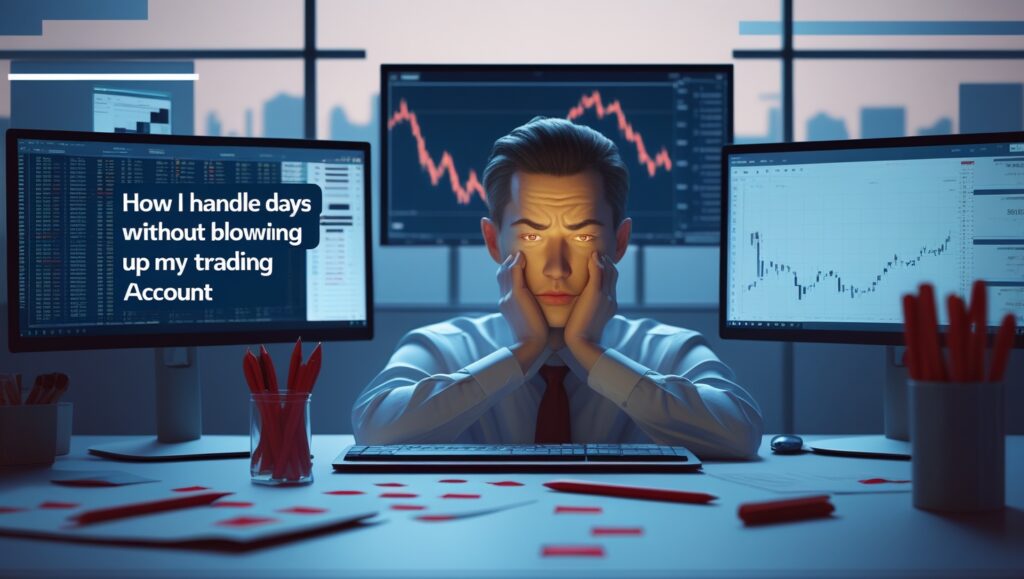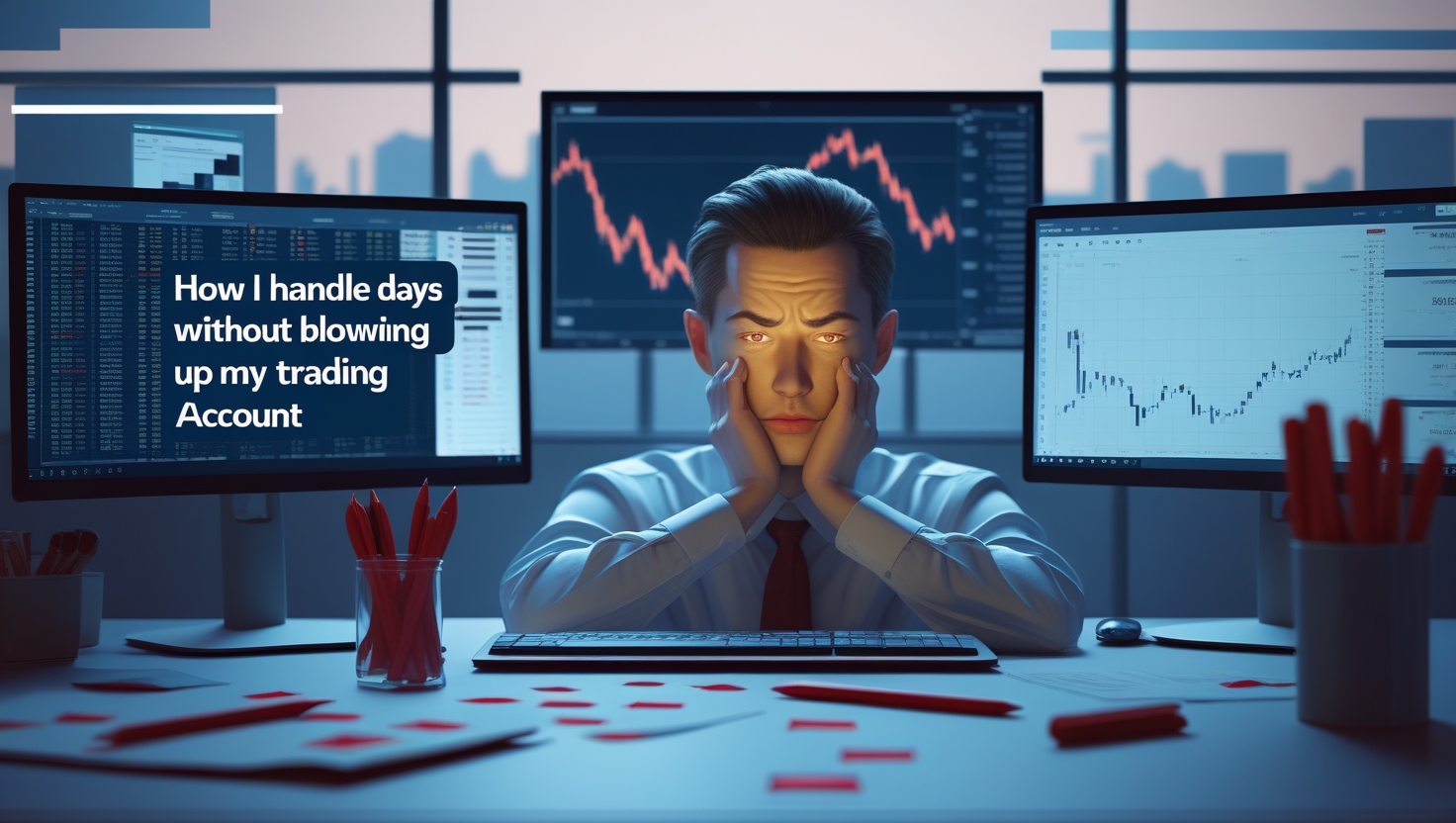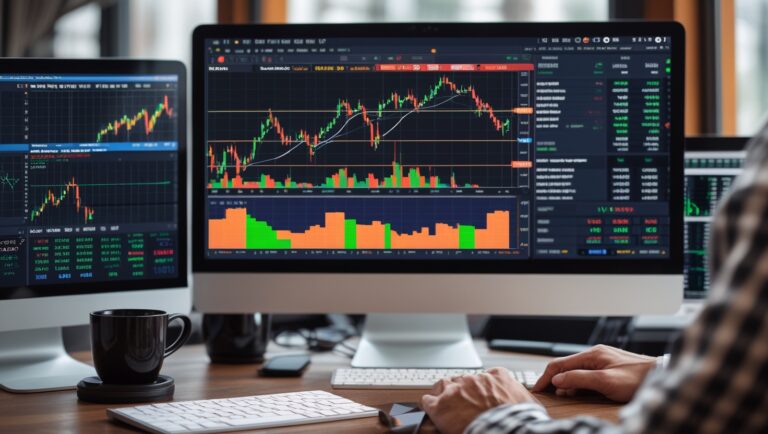How I Handle Red Days Without Blowing Up My Account
How I Handle Red Days Without Blowing Up My Account
Every trader has red days. It doesn’t matter how experienced you are or how perfect your setup looked — sometimes the market just doesn’t cooperate. But the difference between traders who last and those who blow up is simple:
It’s not about avoiding red days — it’s about knowing how to handle them.
I’ve had my fair share of losing days, but I’ve also learned how to keep them from turning into disasters. Here’s exactly how I handle red days without blowing up my account.

Table of Contents
Rule #1: Stop the Bleeding Early
One of the most important habits I’ve built is setting a daily max loss limit. I know ahead of time how much I’m willing to lose for the day — and once I hit it, I’m done. No “just one more trade” to make it back. That rule has saved me more times than I can count.
Sometimes the market just isn’t in sync with me, and that’s okay. Walking away protects my capital and my mindset.
Rule #2: Avoid the Revenge Trade Trap
This one took me a while to learn. After a loss, it’s easy to want to jump back in and “fix” it. But revenge trading is almost always emotional — and emotion-based trades are sloppy trades.
When I feel that urge rising, I literally say out loud: “That trade is done. Let it go.” It sounds silly, but it helps me reset my thinking. One bad trade doesn’t define me — but how I react to it does.
Rule #3: Review, Don’t React
After the market closes, I go back and look at what went wrong. I check my journal, screenshots, and ask myself:
- Did I follow my plan?
- Was the setup valid?
- Did I manage risk properly?
If I did everything right and still lost — that’s part of trading. If I broke my rules? That’s a chance to learn. Either way, I treat red days as a classroom, not a courtroom.
Rule #4: Keep Losses Small and Measured
I never let one trade take me out of the game. I risk a fixed percentage of my capital on each setup, which keeps my losses small and manageable. That’s how I stay in control — even when the market doesn’t cooperate.
Red days don’t hurt as much when they’re just part of the plan. I don’t aim for perfection. I aim for consistency and survival.
Want to Know How I Keep Trading Simple and Safe?
If you’re trying to build a process that helps you survive red days and grow your account slowly and smartly, everything I use is inside my ebook:
It breaks down my daily prep, risk management rules, and how I trade with clarity instead of chaos — so that even when I lose, I stay in control.
Final Thoughts
Red days will come. What matters is how you respond to them. You can’t control the market, but you can control your risk, your mindset, and your reactions.
I don’t fear red days anymore. I respect them. I use them. And most importantly — I keep them from taking me out of the game.
If you want to trade long-term, learn to lose the right way. Protect your capital. Protect your mindset. And trust that staying alive in this game is the first win.
There were times early on when one red day would spiral into a red week — all because I didn’t know how to stop. I’d take a loss, get frustrated, and try to make it back by jumping into the next random setup I saw. And the more I chased, the worse it got. That’s how accounts blow up — not from one trade, but from the spiral after it.
Now I understand that trading is a long game, and red days are just part of the equation. I remind myself that one trade, one session, or even one bad week doesn’t erase the bigger picture. That mindset shift alone keeps me grounded during losing streaks.
I also keep a post-red-day checklist. Instead of going into the next session blindly, I reset with structure. I reread my rules, review my last trades, and give myself permission to go slower the next day. That reset routine helps me recover mentally and come back sharp — not shaken.
Sometimes I even take the next day off completely. I don’t trade just because the market is open. If I’m emotionally off, I give myself space to cool down and regain clarity. There’s no shame in stepping back. The market will still be there tomorrow.
What surprised me the most was how empowering it felt to stick to a loss limit and walk away. Before, I thought walking away meant giving up. Now I see it as a sign of control and maturity as a trader. Quitting for the day isn’t losing — it’s protecting your edge.
I also remind myself often: risk is part of this business. There is no strategy that wins 100% of the time. Even the best setups fail. What matters is how I handle it when they do. If I’m managing risk, using size correctly, and sticking to my plan — I’m still doing my job.
After red days, I look at my trading journal and try to find one lesson I can take away. Maybe I sized in too big. Maybe I ignored a warning sign. Or maybe I did everything right and the market just didn’t go my way. Either way, I write it down. That’s how I improve.
I’ve also learned to separate emotion from identity. A red day doesn’t mean I’m a bad trader. It means the market didn’t offer what I needed, or I misread it. But either way, I remind myself — I’m still a student of the game. And students keep showing up.
The emotional discipline I’ve built on red days actually helps me on green days too. I don’t get overly confident. I know every win is just one trade in a much bigger picture. And that mindset helps me stay consistent, not just lucky.
If you’re constantly blowing up on red days, you probably need to revisit your risk management first. Then build guardrails: daily loss limits, a revenge trade timeout rule, or even a “three strikes” rule where you walk away after three failed setups. Those rules keep you in the game.
I share all my personal risk rules and structure inside my ebook — including how I plan, size, and handle losses without going off the rails:
👉 Pay Your Bills with Stocks
If you’ve been struggling with discipline or account drawdowns, this will help you start trading with more control and less chaos.
At the end of the day, your job isn’t to avoid red days — it’s to manage them like a pro. If you can learn to lose with structure and come back without emotional baggage, you’ll last longer than most people ever will in this game.

Stay ahead in the stock market! Subscribe to our newsletter and receive exclusive stock flow reports, trading insights, and actionable tips directly in your inbox. Join thousands of traders who get our updates first.







